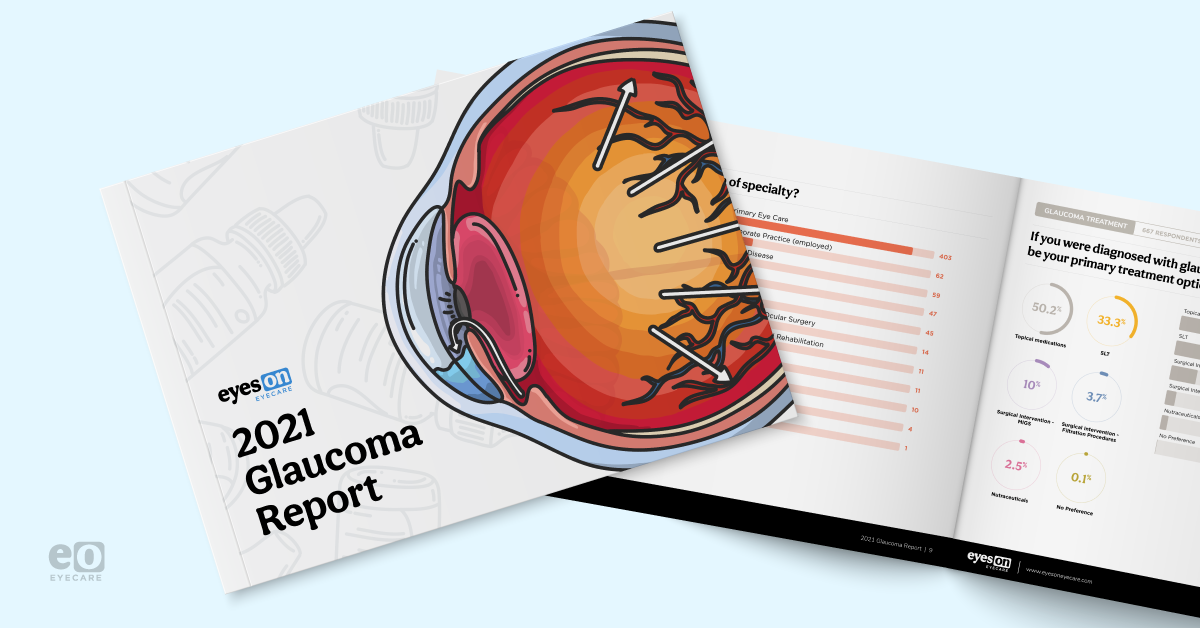According to the CDC, roughly
three million Americans, or 1% of the population, have glaucoma. As the American population continues to age, it’s likely that this statistic will increase; worldwide, glaucoma is the third leading cause of blindness, accounting for up to
14% of the total blind population.
As this disease grows in prevalence, optometrists and their colleagues will undoubtedly seek to improve and grow the scope of services offered to glaucoma patients. In May 2021, we surveyed 667 optometrists to learn more about how they are approaching glaucoma diagnosis, treatment, and management. The result is the 2021 Glaucoma Report—and as with all Eyes On Eyecare reports, this exclusive data is absolutely free to download!
Download the 2021 Glaucoma Report now or keep reading for a sneak peek at the findings!
Download the 2021 Glaucoma Report
Get free access to over 20 pages of data!
The 2021 Glaucoma Report covers:
- Average confidence in diagnosing glaucoma: How comfortable are optometrists diagnosing glaucoma patients?
- Glaucoma prevalence among patient populations: How many of your patients have been diagnosed with glaucoma?
- Go-to front-line treatments for glaucoma: What are the top treatments prescribed by optometrists? How do they differ from the treatments optometrists would choose for themselves?
- Patient compliance: What percentage of patients are fully compliant with topical treatments?
- Referrals and co-management: How do optometrists rank their current referral and co-management process? What percentage of patients are referred out to ophthalmology or other optometrists?
- And more!
Optometrists are confident in glaucoma diagnosis, even if they don’t treat
Respondents estimated that 18% of their patients had been diagnosed with glaucoma, a difference that only emphasizes how important eyecare has become for the aging US population.
Confidence in diagnosing and treating glaucoma was high (averaging over 7 out of 10 for both categories), and optometrists ranked the quality of glaucoma education they receive in optometry school at an average 7.19 out of 10.
Practice scope allows more optometrists to treat glaucoma than ever
With the recent updates to
scope of practice laws, optometrists across the country can now treat glaucoma with topical medications, and optometrists are taking advantage of this capacity. With medical education more advanced than ever, optometrists feel strongly equipped to diagnose, treat, and manage glaucoma, and nearly 80% of our survey respondents are doing so.
Favored front-line treatments: drops vs lasers
The vast majority (85%) of optometrists cite topical medications as their go-to front-line treatment for
primary open angle glaucoma. Latanoprost and Lumigan were among the most popular topical medications.
For many optometrists, the biggest challenge in glaucoma diagnosis, treatment, and management will come as no surprise: patient compliance. Survey respondents estimated that barely half of their glaucoma patients are fully compliant with their drops.
Most interestingly, while the vast majority of optometrists cite
topical medications as their go-to front-line treatment for primary open angle glaucoma. However, only 50% would prefer topical medications as their primary treatment if they were diagnosed with glaucoma, with another 33% preferring SLT.
This difference makes sense: after all, SLT is not within optometrists’ scope of practice in all states.
Building relationships with co-management and referrals
When it comes to referrals and co-management of glaucoma, it’s interesting to see optometrists rate the quality of the co-management process for glaucoma patients within their practice at a 6.87 out of 10, a number that isn’t terrible but can certainly be improved.
On average, optometrists refer out 40% of their glaucoma patients to an ophthalmologist, largely because they believe the patient would benefit from a surgical procedure. We’re hopeful that the co-management processes and relationships between optometrists and ophthalmologists will continue to grow stronger as we collaborate on this and other aspects of our patients’ healthcare.
The ultimate goal of any disease treatment plan is improving patient outcomes and quality of life. With the recent updates in scope of practice laws, optometrists across the US have the opportunity to be on the front lines of glaucoma treatment and management. We’re excited to see that optometrists are taking advantage of this opportunity to grow clinical skills, practice offerings, and the services and care we provide to our patients every day.


